Robust ESD-Reliability Design of 300-V Power N-Channel LDMOSs with the Elliptical Cylinder Super-Junctions in the Drain Side
Abstract
:1. Introduction
2. Device Layouts of UHV 300 V nLDMOS Related Devices
2.1. The Benchmarked Reference Sample (Pure nLDMOS)
2.2. nLDMOS-SJs Samples with SJs Length Modulation
The Symmetrical Eight-Zone Elliptical Cylinder Type (M8) of LDMOS-SJs
2.3. SJs Number Modulation: Six LDMOS-SJs Devices with the Symmetrical Four-Zone Elliptical Cylinder Type
3. HBM Testing System
4. Experimental Data and Discussion
5. Conclusions
Author Contributions
Funding
Acknowledgments
Conflicts of Interest
Nomenclature
| BCD | Bipolar-CMOS-DMOS |
| BJT | Bipolar-junction transistor |
| BNW | Buried N-type well |
| DPW | Deep P-type well |
| DUT | Device under test |
| ESD | Electrostatic discharge |
| GGnMOS | Gate-grounded nMOSFET |
| nLDMOS | N-channel lateral diffused MOSFET |
| HBM | Human-body model |
| HVNW | High-voltage N-type well |
| HVPB | High-voltage P-type Base |
| HVPW | High-voltage P-type well |
| IC | Integrated circuit |
| I/O | Input/output |
| Length X | The length of X (the variable length of elliptical cylinders) |
| LV | Low voltage |
| MV | Medium voltage |
| N-EPI | N-type epitaxy layer |
| OD | Thin-oxide definition |
| PBody | P-type body layer |
| RESURF | Reduced surface field |
| Ron | On-resistance |
| SJ | Super junction |
| STI | Shallow trench isolation |
| UHV | Ultra high-voltage |
| Vbk | Breakdown voltage |
References
- Aoike, N.; Hoshino, M.; Iwabuchi, A. Automotive HID headlamps producing compact electronic ballasts using power ICs. IEEE Ind. Appl. Mag. 2002, 8, 37–41. [Google Scholar] [CrossRef]
- Tee, E.K.C.; Julai, N.; Hai, H.Y.; Pal, D.K.; Hua, T.S. Design of 0.18um high voltage LDMOS for automotive application. In Proceedings of the IEEE International Conference on Semiconductor Electronics, Johor Bahru, Malaysia, 27 November 2008; pp. 6–10. [Google Scholar]
- DeVincentis, M.; Hollingsworth, G.; Gilliard, R. Long life solid-state RF powered light sources for projection display and general lighting applications. In Proceedings of the IEEE MTT-S International Microwave Symposium Digest, Atlanta, GA, USA, 15–20 June 2008; pp. 1497–1500. [Google Scholar]
- Shirai, K.; Yonemura, K.; Watanabe, K.; Kimura, K. Ultra-low on-resistance LDMOS implementation in 0.13µm CD and BiCD process technologies for analog power IC’s. In Proceedings of the 21st International Symposium on Power Semiconductor Devices & ICs (ISPSD), Barcelona, Spain, 14–18 June 2009; pp. 77–79. [Google Scholar]
- Wang, Y.; Zhang, D.; Lv, Y.; Gong, D.; Shao, K.; Wang, Z.; He, D.; Cheng, X. A simulation study of SOI RESURF junctions for HV LDMOS (>600V). In Proceedings of the International Workshop on Junction Technology, Shanghai, China, 10–11 May 2010; pp. 1–4. [Google Scholar]
- Zhu, J.; Qian, Q.; Sun, W.; Lu, S.; Lin, Y. A novel compact isolated structure for 600V Gate Drive IC. In Proceedings of the IEEE International Conference of Electron Devices and Solid-State Circuits, Tianjin, China, 17–18 November 2011; pp. 1–2. [Google Scholar]
- Liu, S.; Sun, W.; Huang, T.; Zhang, C. Novel 200V power devices with large current capability and high reliability by inverted HV-well SOI technology. In Proceedings of the 25th International Symposium on Power Semiconductor Devices & ICs (ISPSD), Kanazawa, Japan, 26–30 May 2013; pp. 115–118. [Google Scholar]
- Huang, Y.-J.; Ker, M.-D.; Huang, Y.-J.; Tsai, C.-C.; Jou, Y.-N.; Lin, G.-L. ESD protection design with latchup-free immunity in 120V SOI process. In Proceedings of the IEEE SOI-3D-Subthreshold Microelectronics Technology Unified Conference (S3S), Rohnert Park, CA, USA, 5–8 October 2015; pp. 1–2. [Google Scholar]
- Ko, K.; Park, J.; Eum, J.; Lee, K.; Lee, S.; Lee, J. Proposal of 0.13um new structure LDMOS for automotive PMIC. In Proceedings of the 73rd Annual Device Research Conference (DRC), Columbus, OH, USA, 21–24 June 2015; pp. 119–120. [Google Scholar]
- Zierak, M.; Feilchenfeld, N.; Li, C.; Letavic, T. Fully-isolated silicon RF LDMOS for high-efficiency mobile power conversion and RF amplification. In Proceedings of the IEEE 27th International Symposium on Power Semiconductor Devices & ICs (ISPSD), Hong Kong, China, 10–14 May 2015; pp. 337–340. [Google Scholar]
- Chen, Y.; Chang, C.; Yang, P. A Novel Primary-Side Controlled Universal-Input AC–DC LED Driver Based on a Source-Driving Control Scheme. IEEE Trans. Power Electron. 2015, 30, 4327–4335. [Google Scholar] [CrossRef]
- Chang, C.; Jiang, T.; Yang, P.; Xu, Y.; Chen, Y. Adaptive line voltage compensation scheme for a source-driving controlled AC–DC LED driver. IET Circuitsdevices Syst. 2017, 11, 21–28. [Google Scholar] [CrossRef]
- Matsuda, J.-I.; Kuwana, A.; Kojima, J.-Y.; Tsukiji, N.; Kobayashi, H. Wide SOA and High Reliability 60-100 V LDMOS Transistors with Low Switching Loss and Low Specific On-Resistance. In Proceedings of the IEEE International Conference on Solid-State and Integrated Circuit Technology (ICSSICT), Qingdao, China, 31 October–3 November 2018; pp. 1–3. [Google Scholar]
- Wu, C.-Y.; You, H.-C. Effect of SOI LDMOS Epitaxial Layer Thickness on Breakdown Voltage. In Proceedings of the International Symposium on Computer, Consumer and Control (IS3C), Taichung, Taiwan, 6–8 December 2018; pp. 80–83. [Google Scholar]
- Theeuwen, S.J.C.H.; Mollee, H.; Heeres, R.; Van Rijs, F. LDMOS Technology for Power Amplifiers Up to 12 GHz. In Proceedings of the 13th European Microwave Integrated Circuits Conference (EuMIC), Madrid, Spain, 23–25 September 2018; pp. 162–165. [Google Scholar]
- Malik, W.A.; Abdulkawi, W.M.; Sheta, A.A.; Alzakari, N.F. A 6 Watts LDMOS Wideband Balanced Power Amplifier. In Proceedings of the 16th International Bhurban Conference on Applied Sciences and Technology (IBCAST), Islamabad, Pakistan, 8–12 January 2019; pp. 1053–1056. [Google Scholar]
- van Zwol, J.; van den Berg, A.; Smedes, T. ESD Protection by Keep-On Design for a 550 V Fluorescent Lamp Control IC with Integrated LDMOS Power Stage. In Proceedings of the Electrical Overstress/Electrostatic Discharge Symposium, Orlando, FL, USA, 10–12 September 2002; pp. 270–276. [Google Scholar]
- Vashchenko, V.-A.; Gallerano, A.; Shibkov, A. On chip ESD protection of 600V voltage node. In Proceedings of the IEEE 23rd International Symposium on Power Semiconductor Devices and ICs (ISPSD), San Diego, CA, USA, 23–26 May 2011; pp. 128–131. [Google Scholar]
- Lee, J.-H.; Kao, T.-C.; Chan, C.-L.; Su, J.-L.; Su, H.-D.; Chang, K.-C. The ESD failure mechanism of ultra-HV 700V LDMOS. In Proceedings of the IEEE 23rd International Symposium on Power Semiconductor Devices and ICs (ISPSD), San Diego, CA, USA, 23–26 May 2011; pp. 188–191. [Google Scholar]
- Kanawati, R.; Parvin, A.; Rotshtein, I.; Quon, D.; Yankelevich, A.; Aloni, E.; Eyal, A.; Shapira, S. ESD protection schemes and devices embedded in a 700V integrated power management platform. In Proceedings of the IEEE International Conference on Microwaves Communications, Antennas and Electronics Systems (COMCAS), Tel Aviv, Israel, 7–9 November 2011; pp. 1–4. [Google Scholar]
- Tsai, J.-R.; Lee, Y.-M.; Tsai, M.-C.; Sheu, G.; Yang, S.-M. Development of ESD robustness enhancement of a novel 800V LDMOS multiple RESURF with linear P-top rings. In Proceedings of the TENCON 2011—IEEE Region 10 Conference, Bali, Indonesia, 21–24 November 2011; pp. 760–763. [Google Scholar]
- Kim, S.-B.; Geum, J.; Kyoung, S.; Sung, M.-Y. On-chip stacked Punchthrough diode design for 900V power MOSFET gate ESD protection. In Proceedings of the 12th IEEE International Conference on Solid-State and Integrated Circuit Technology (ICSICT), Guilin, China, 28–31 October 2014; pp. 1–3. [Google Scholar]
- Wu, C.-H.; Lee, J.-H.; Lien, C. A Novel Drain Design for ESD Improvement of UHV-LDMOS. IEEE Trans. Electron Devices 2015, 62, 4135–4138. [Google Scholar] [CrossRef]
- Chen, Z.; Salman, A.; Mathur, G.; Boselli, G. Design and optimization on ESD self-protection schemes for 700V LDMOS in high voltage power IC. In Proceedings of the 37th Electrical Overstress/Electrostatic Discharge Symposium (EOS/ESD), Reno, NV, USA, 27 September–2 October 2015; pp. 1–6. [Google Scholar]
- Sheu, G.; Li, Y.-H. An innovated 500V UHV ESD self-protection device structure. In Proceedings of the International Conference on Electron Devices and Solid-State Circuits (EDSSC), Hsinchu, Taiwan, 18–20 October 2017; pp. 1–2. [Google Scholar]
- Kim, S.; LaFonteese, D.; Zhu, D.; Sridhar, D.S.; Pendharkar, S.; Endoh, H.; Boku, K. A new ESD self-protection structure for 700V high side gate drive IC. In Proceedings of the International Symposium on Power Semiconductor Devices and ICs (ISPSD), Sapporo, Japan, 28 May–1 June 2017; pp. 467–470. [Google Scholar]
- Pjenčák, J.; Agam, M.; Šeliga, L.; Yao, T.; Suwhanov, A. Novel approach for NLDMOS performance enhancement by critical electric field engineering. In Proceedings of the IEEE 30th International Symposium on Power Semiconductor Devices and ICs (ISPSD), Chicago, IL, USA, 13–17 May 2018; pp. 307–310. [Google Scholar]
- Bandi, L.; Hemanth, A.; Kumar, B.H.; Wijaya, A.C.; Sheu, G. Fully Ion-Implanted 1200V LDMOS with Linear P-Top Technology. In Proceedings of the IEEE International Conference on Consumer Electronics—Taiwan (ICCE-TW), Yilan, Taiwan, 20–22 May 2019; pp. 1–2. [Google Scholar]
- Amberetu, M.A.; Salama, C.A.T. 150-V class superjunction power LDMOS transistor switch on SOI. In Proceedings of the 14th International Symposium on Power Semiconductor Devices and ICs (ISPSD), Sante Fe, NM, USA, 7 June 2002; pp. 101–104. [Google Scholar]
- Permthammasin, K.; Wachutka, G.; Schmitt, M.; Kapels, H. Performance Analysis of Novel 600V Super-Junction Power LDMOS Transistors with Embedded P-Type Round Pillars. In Proceedings of the International Conference on Simulation of Semiconductor Processes and Devices, Tokyo, Japan, 1–3 September 2005; pp. 179–182. [Google Scholar]
- Permthammasin, K.; Wachutka, G.; Schmitt, M.; Kapels, H. New 600V Lateral Superjunction Power MOSFETs Based on Embedded Non-Uniform Column Structure. In Proceedings of the International Conference on Advanced Semiconductor Devices and Microsystems, Smolenice Castle, Slovakia, 16–18 October 2006; pp. 263–266. [Google Scholar]
- Park, I.-Y.C.; Salama, C.A.T. Super Junction LDMOS Transistors-Implementing super junction LDMOS transistors to overcome substrate depletion effects. IEEE Circuits Devices Mag. 2006, 22, 10–15. [Google Scholar] [CrossRef]
- Duan, B.; Yang, Y.; Zhang, B. New Superjunction LDMOS with N-Type Charges’ Compensation Layer. IEEE Electron Device Lett. 2009, 30, 305–307. [Google Scholar] [CrossRef]
- Park, I.-Y.; Choi, Y.-K.; Ko, K.-Y.; Yoon, C.-J.; Kim, Y.-S.; Kim, M.-Y.; Kim, H.-T.; Lim, H.-C.; Kim, N.-J.; Yoo, K.-D. Implementation of buffered Super-Junction LDMOS in a 0.18 um BCD process. In Proceedings of the 21st International Symposium on Power Semiconductor Devices & ICs (ISPSD), Barcelona, Spain, 14–18 June 2009; pp. 192–195. [Google Scholar]
- Qiao, M.; Wang, W.-L.; Li, Z.-J.; Zhang, B. Super junction LDMOS technologies for power integrated circuits. In Proceedings of the IEEE 11th International Conference on Solid-State and Integrated Circuit Technology (ICSICT), Xi’an, China, 29 October–1 November 2012; pp. 1–4. [Google Scholar]
- Panigrahi, S.K.; Gogineni, U.; Baghini, M.S.; Iravani, F. 120 V super junction LDMOS transistor. In Proceedings of the IEEE International Conference of Electron Devices and Solid-state Circuits (EDSSC), Hong Kong, China, 3–5 June 2013; pp. 1–2. [Google Scholar]
- Duan, B.; Yuan, S.; Cao, Z.; Yang, Y. New Superjunction LDMOS with the Complete Charge Compensation by the Electric Field Modulation. IEEE Electron Device Lett. 2014, 35, 1115–1117. [Google Scholar] [CrossRef]
- Duan, B.; Cao, Z.; Yuan, S.; Yang, Y. Complete 3D-Reduced Surface Field Superjunction Lateral Double-Diffused MOSFET Breaking Silicon Limit. IEEE Electron Device Lett. 2015, 36, 1348–1350. [Google Scholar] [CrossRef]
- Jagannathan, R.; Hoenes, H.-P.; Duggal, T. Impacts of package, layout and freewheeling diode on switching characteristics of Super Junction MOSFET in automotive DC-DC applications. In Proceedings of the IEEE International Conference on Power Electronics, Drives and Energy Systems (PEDES), Kerala, India, 14–17 December 2016; pp. 1–6. [Google Scholar]
- Cao, Z.; Duan, B.; Cai, H.; Yuan, S.; Yang, Y. Theoretical Analyses of Complete 3-D Reduced Surface Field LDMOS With Folded-Substrate Breaking Limit of Superjunction LDMOS. IEEE Trans. Electron Devices 2016, 63, 4865–4872. [Google Scholar] [CrossRef]
- Zhang, W.; Zhang, B.; Qiao, M.; Li, Z.; Luo, X.; Li, Z. Optimization of Lateral Superjunction Based on the Minimum Specific ON-Resistance. IEEE Trans. Electron Devices 2016, 63, 1984–1990. [Google Scholar] [CrossRef]
- Tsai, J.-Y.; Hu, H.-H. New Super-Junction LDMOS Based on Poly-Si Thin-Film Transistors. IEEE J. Electron Devices Soc. 2016, 4, 430–435. [Google Scholar] [CrossRef]
- Park, J.; Lee, J.-H. A 650 V Super-Junction MOSFETw ith Novel Hexagonal Structure for Superior Static Performance and High BV Resilience to Charge Imbalance: A TCAD Simulation Study. IEEE Electron Device Lett. 2017, 38, 111–114. [Google Scholar] [CrossRef]
- Cao, Z.; Duan, B.; Yuan, S.; Guo, H.; Lv, J.; Shi, T.; Yang, Y. Novel superjunction LDMOS with multi-floating buried layers. In Proceedings of the 29th International Symposium on Power Semiconductor Devices and ICs (ISPSD), Sapporo, Japan, 28 May–1 June 2017; pp. 283–286. [Google Scholar]
- Gui, H.; Zhang, Z.; Ren, R.; Chen, R.; Niu, J.; Tolbert, L.M.; Wang, F.; Blalock, B.J.; Costinett, D.J.; Choi, B.B. SiC MOSFET versus Si Super Junction MOSFET-Switching Loss Comparison in Different Switching Cell Configurations. In Proceedings of the IEEE Energy Conversion Congress and Exposition (ECCE), Portland, OR, USA, 23–27 September 2018; pp. 6146–6151. [Google Scholar]
- Cheng, J.; Chen, W.; Li, P. Improvement of Deep-Trench LDMOS With Variation Vertical Doping for Charge-Balance Super-Junction. IEEE Trans. Electron Devices 2018, 65, 1404–1410. [Google Scholar] [CrossRef]
- Cao, Z.; Duan, B.; Shi, T.; Dong, Z.; Guo, H.; Yang, Y. Theory Analyses of SJ-LDMOS With Multiple Floating Buried Layers Based on Bulk Electric Field Modulation. IEEE Trans. Electron Devices 2018, 65, 2565–2572. [Google Scholar] [CrossRef]
- Tang, P.-P.; Wang, Y.; Bao, M.-T.; Luo, X.; Cao, F.; Yu, C.-H. Improving breakdown performance for SOI LDMOS with sidewall field plate. Micro Nano Lett. 2019, 14, 420–423. [Google Scholar] [CrossRef]
- Duan, B.; Li, M.; Dong, Z.; Wang, Y.; Yang, Y. New Super-Junction LDMOS Breaking Silicon Limit by Multi-Ring Assisted Depletion Substrate. IEEE Trans. Electron Devices 2019, 66, 4836–4841. [Google Scholar] [CrossRef]
- CoolMOS™ SJ MOSFETs Selection Guide; Infineon Technologies: Neubiberg, Germany, 2019; pp. 1–32.
- MIL-STD-883K, Method 3015. 2016. Available online: https://infostore.saiglobal.com/en-us/Standards/MIL-STD-883-K-733707_SAIG_MIL_MIL_1702986 (accessed on 5 March 2018).
- ANSI/ESDA/JEDEC JS-001. 2017. Available online: https://www.jedec.org/document_search?search_api_views_fulltext=JS-001-2017 (accessed on 21 March 2020).
- Quddus, M.-T.; Tu, L.; Ishiguro, T. Drain voltage dependence of on resistance in 700V super junction LDMOS transistor. In Proceedings of the International Symposium on Power Semiconductor Devices & ICs (ISPSD), Kitakyushu, Japan, 24–27 May 2004; pp. 201–204. [Google Scholar]

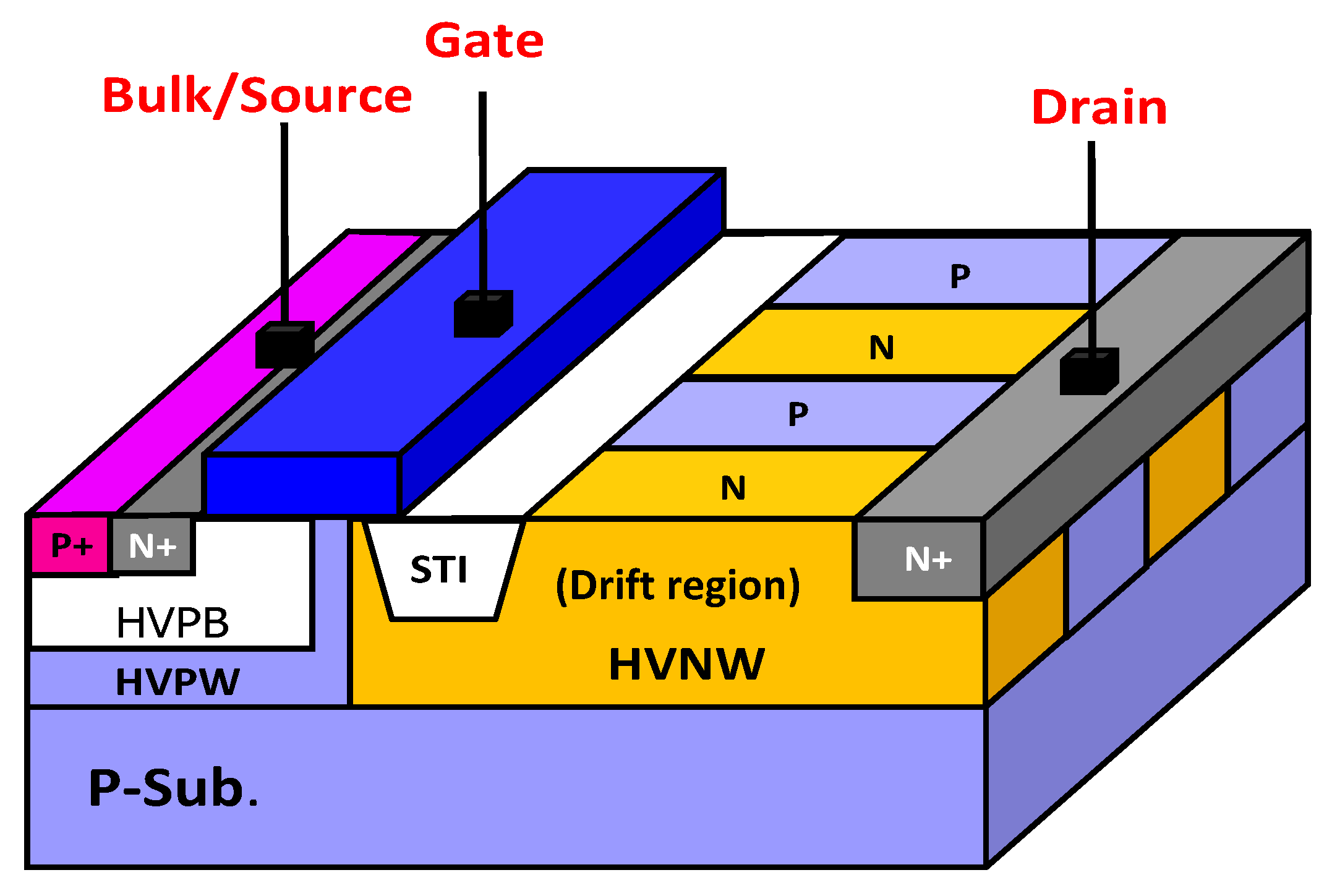
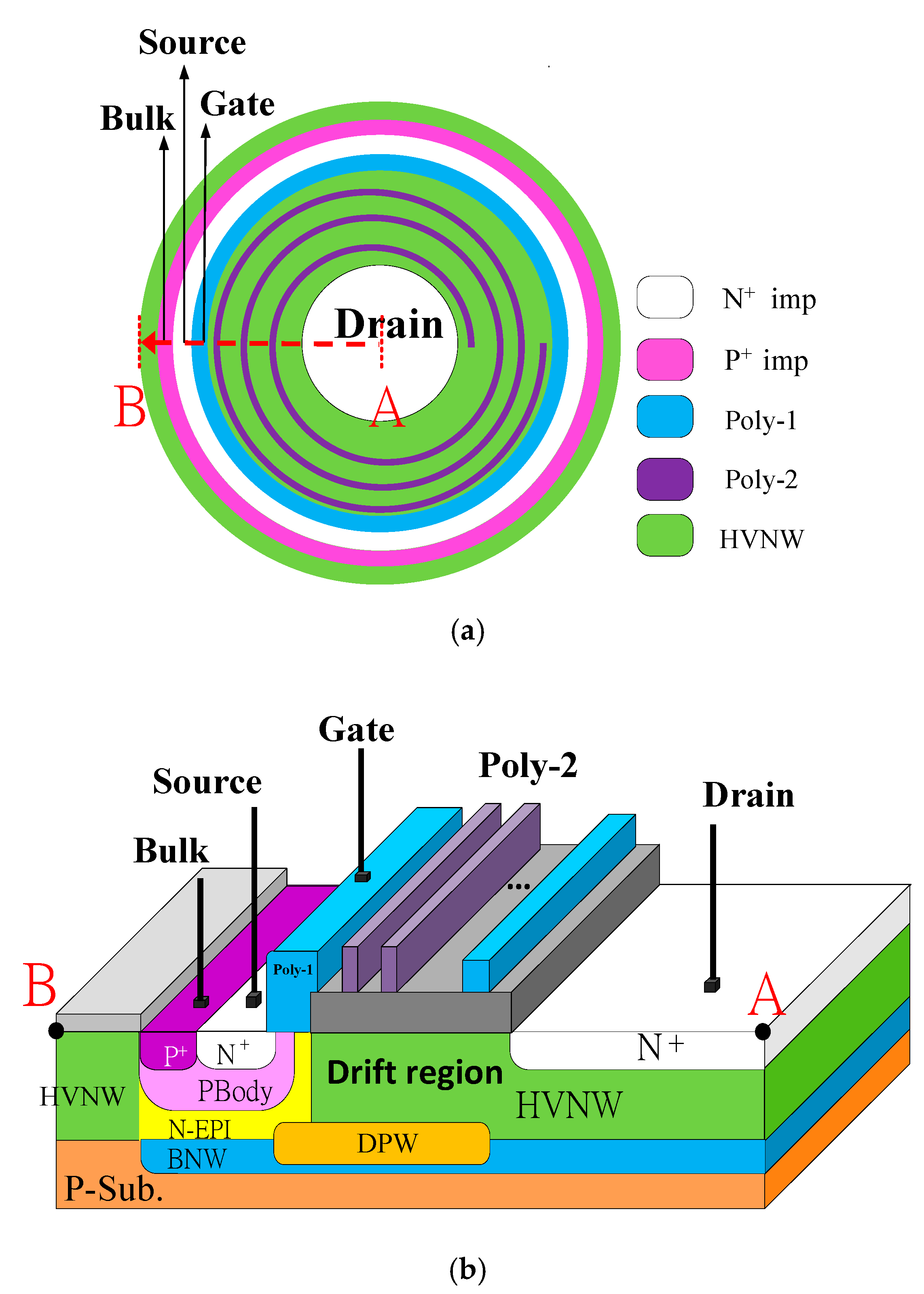
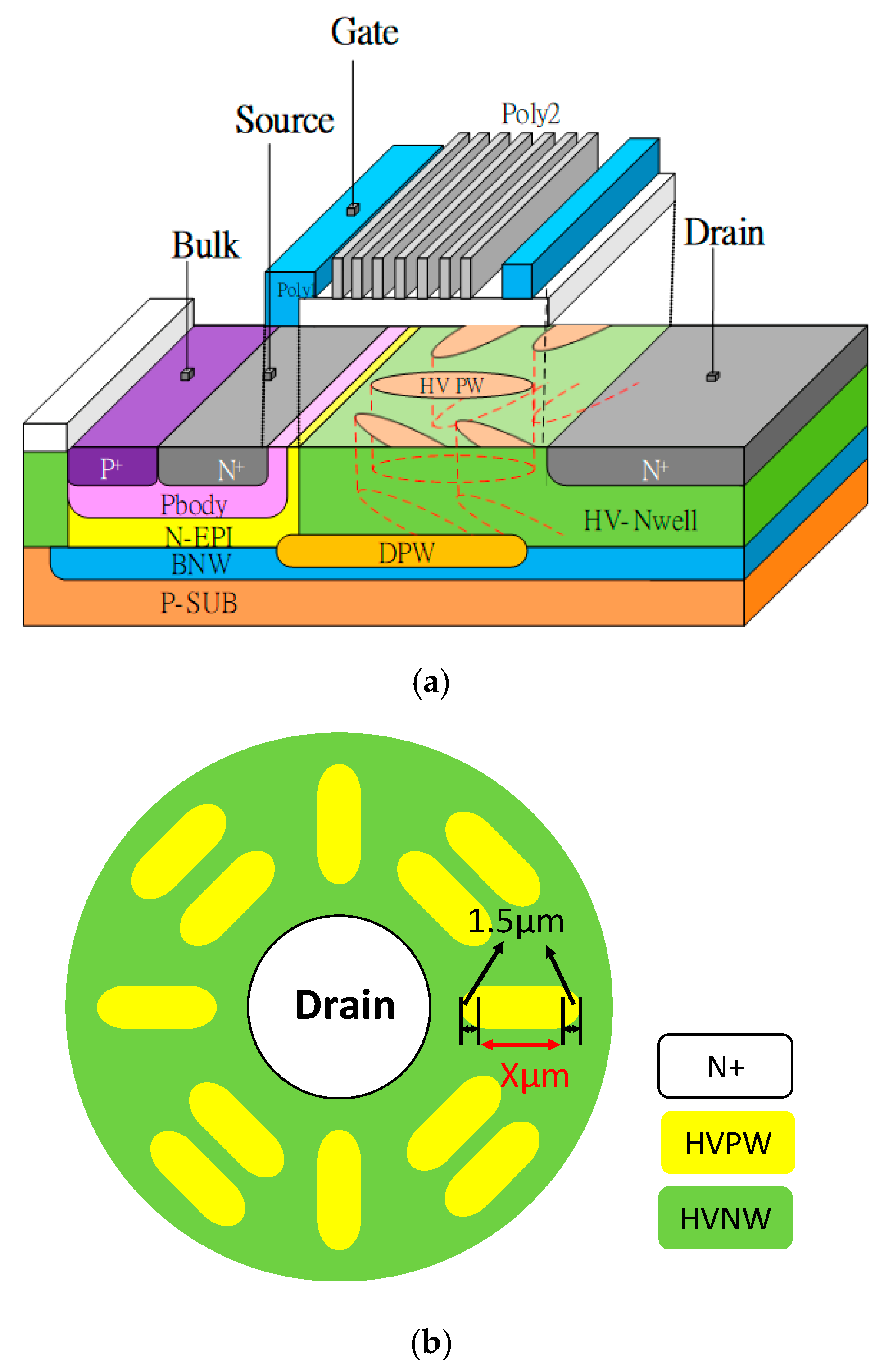
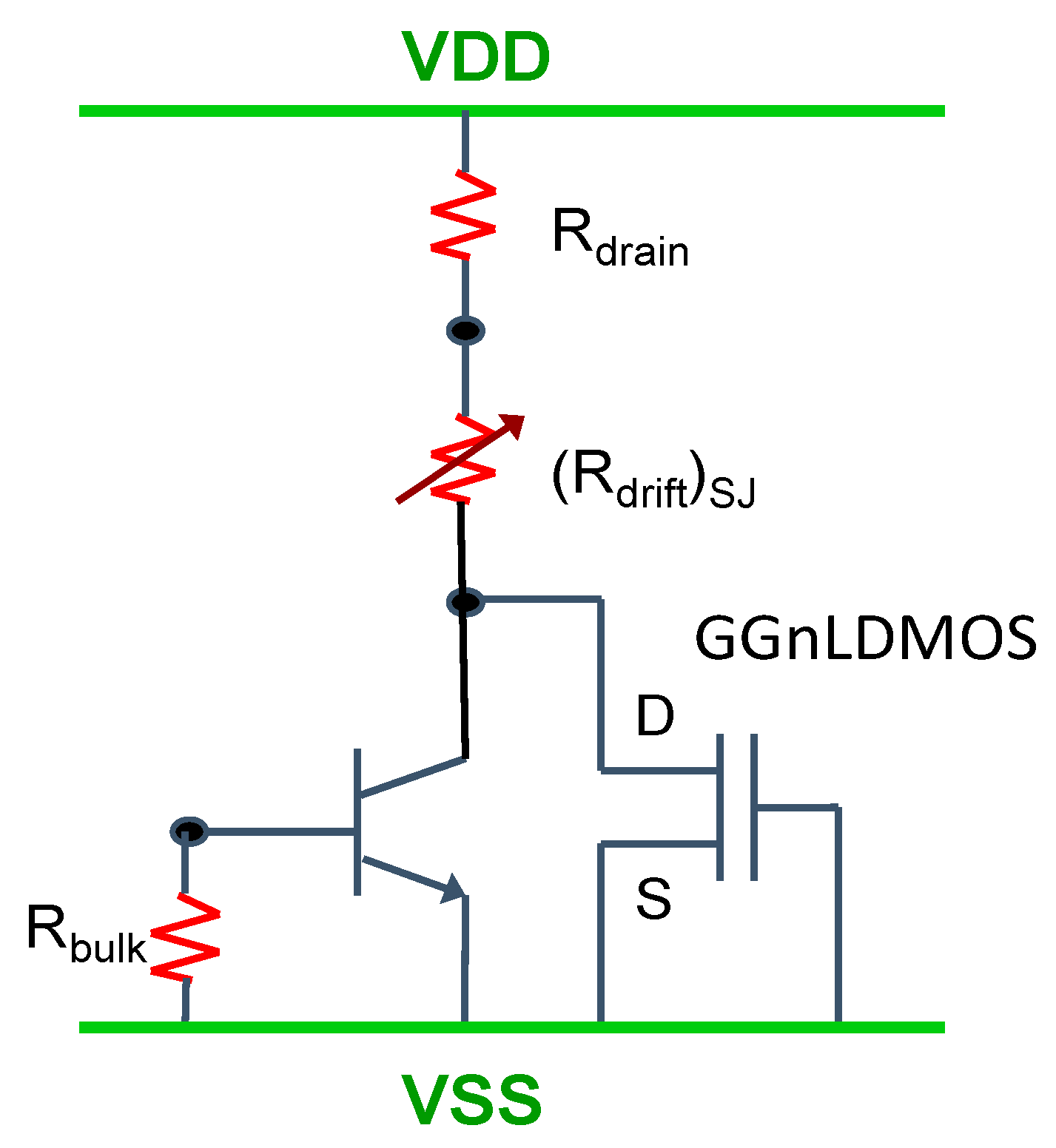
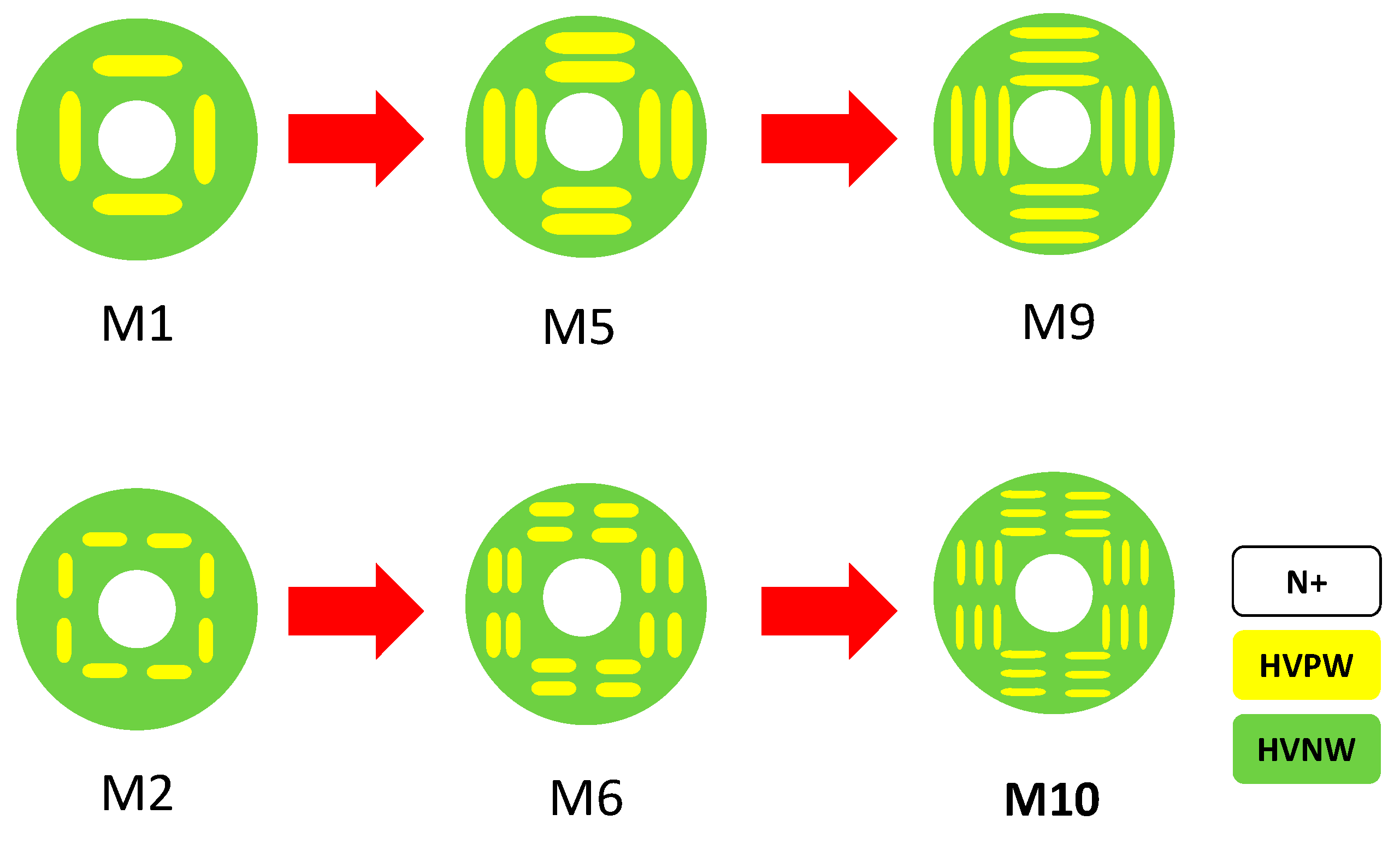
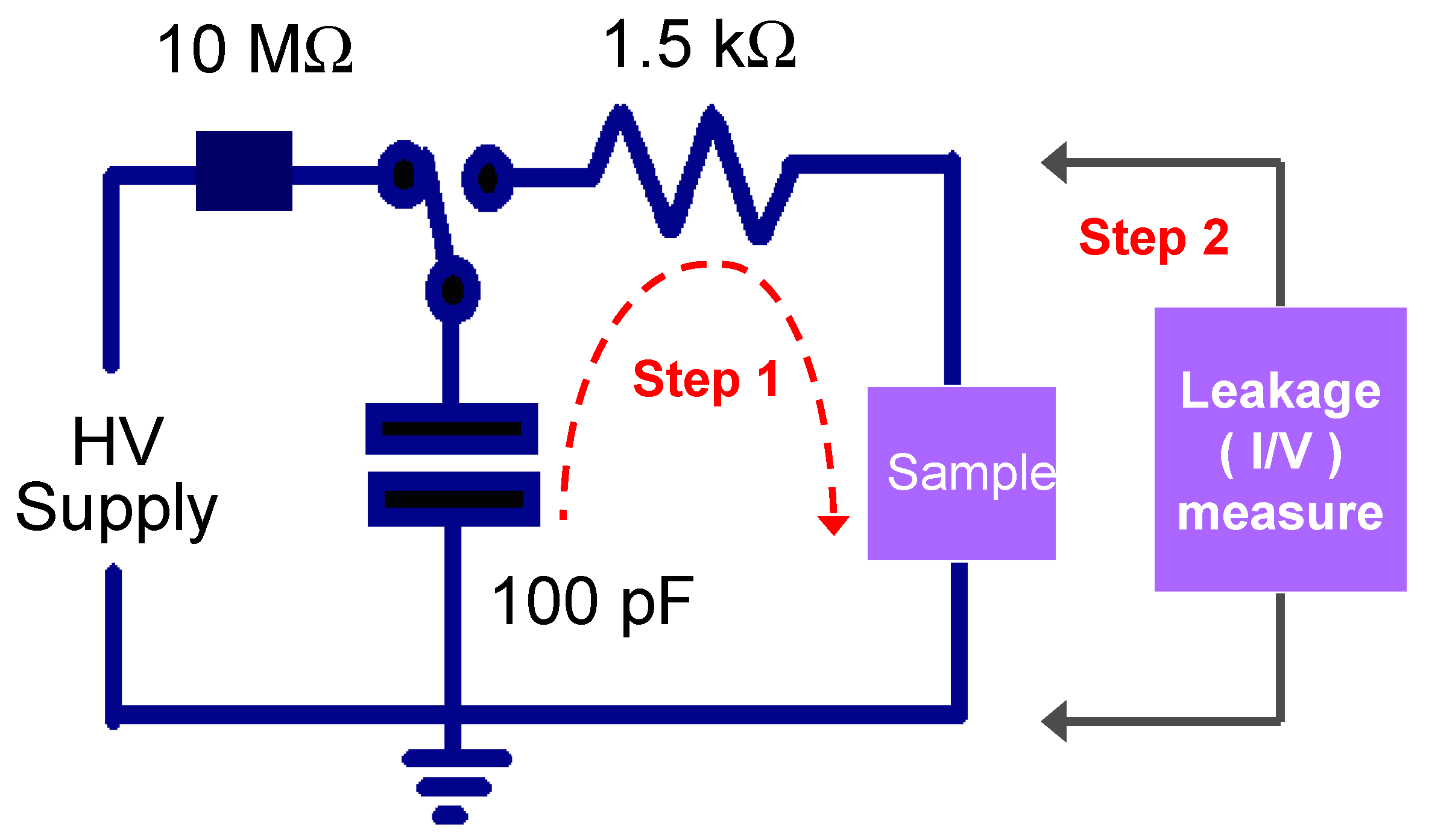

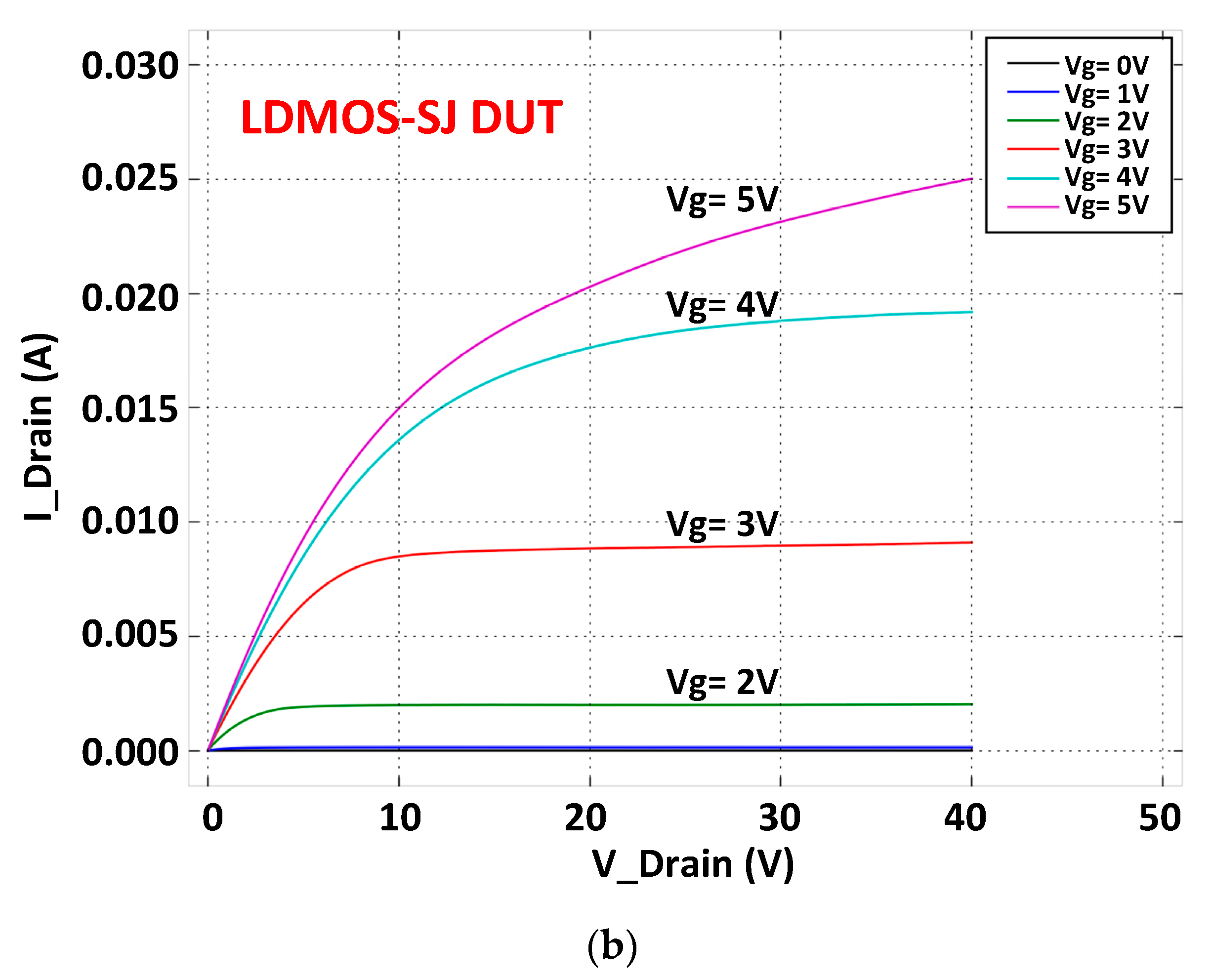
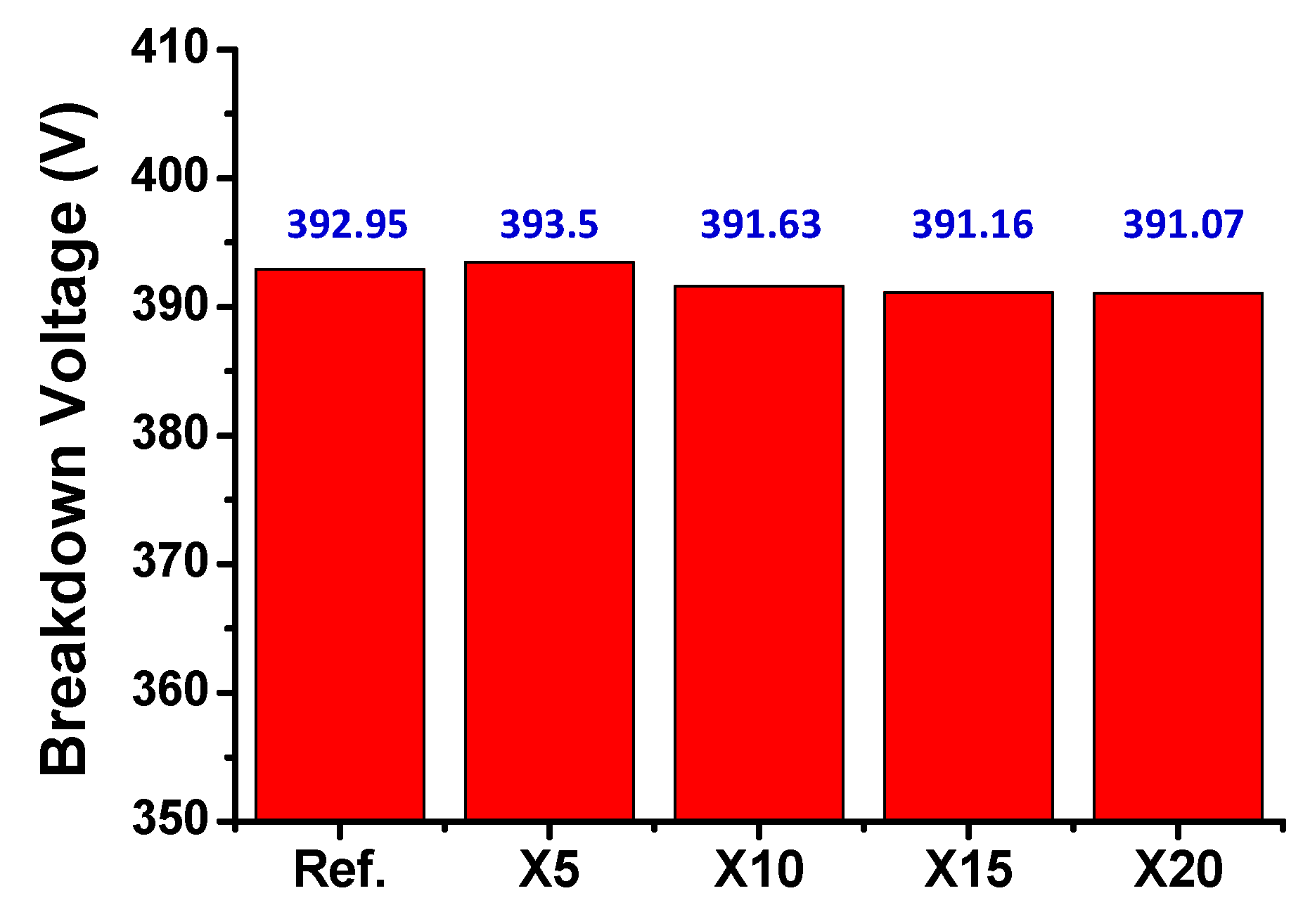
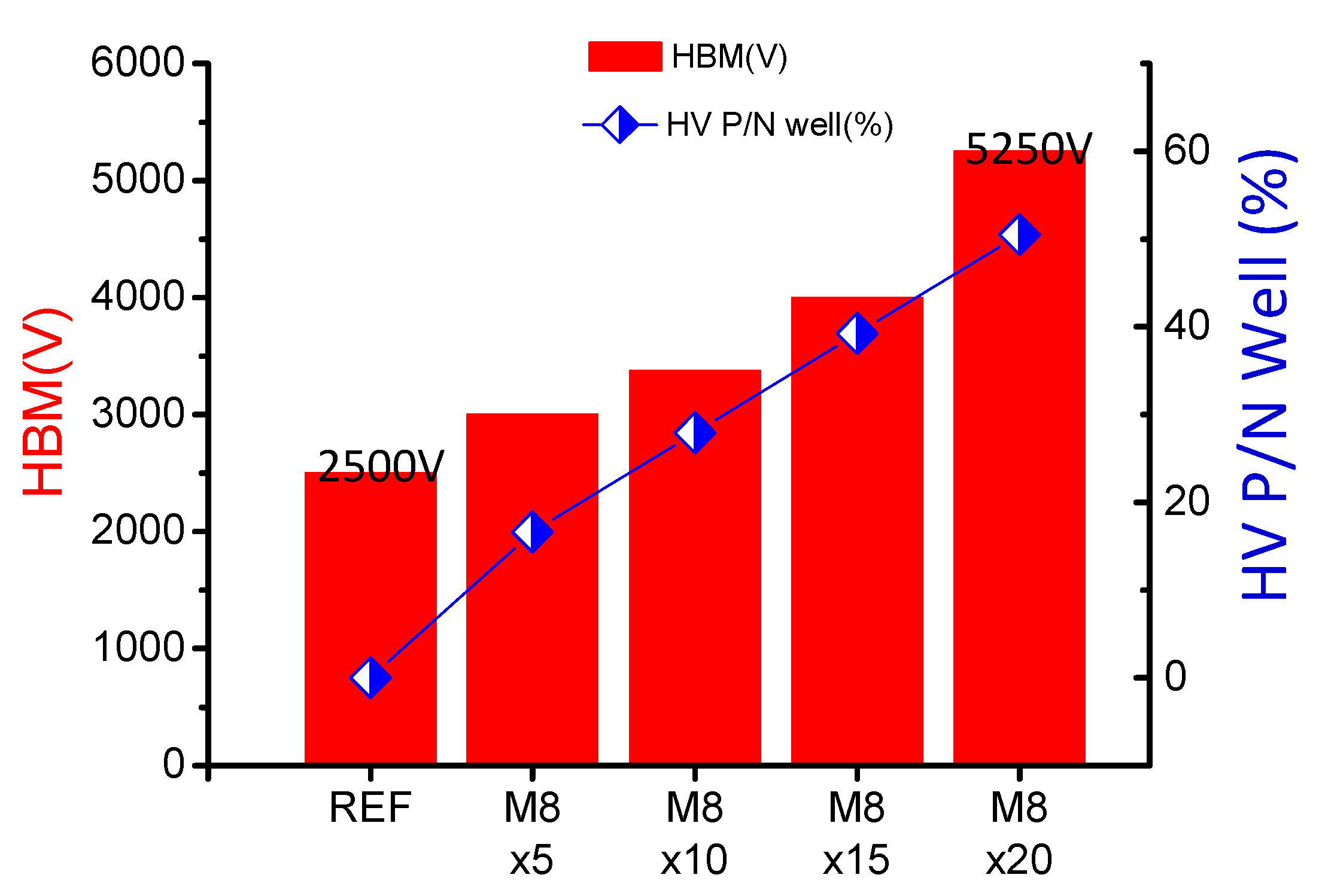
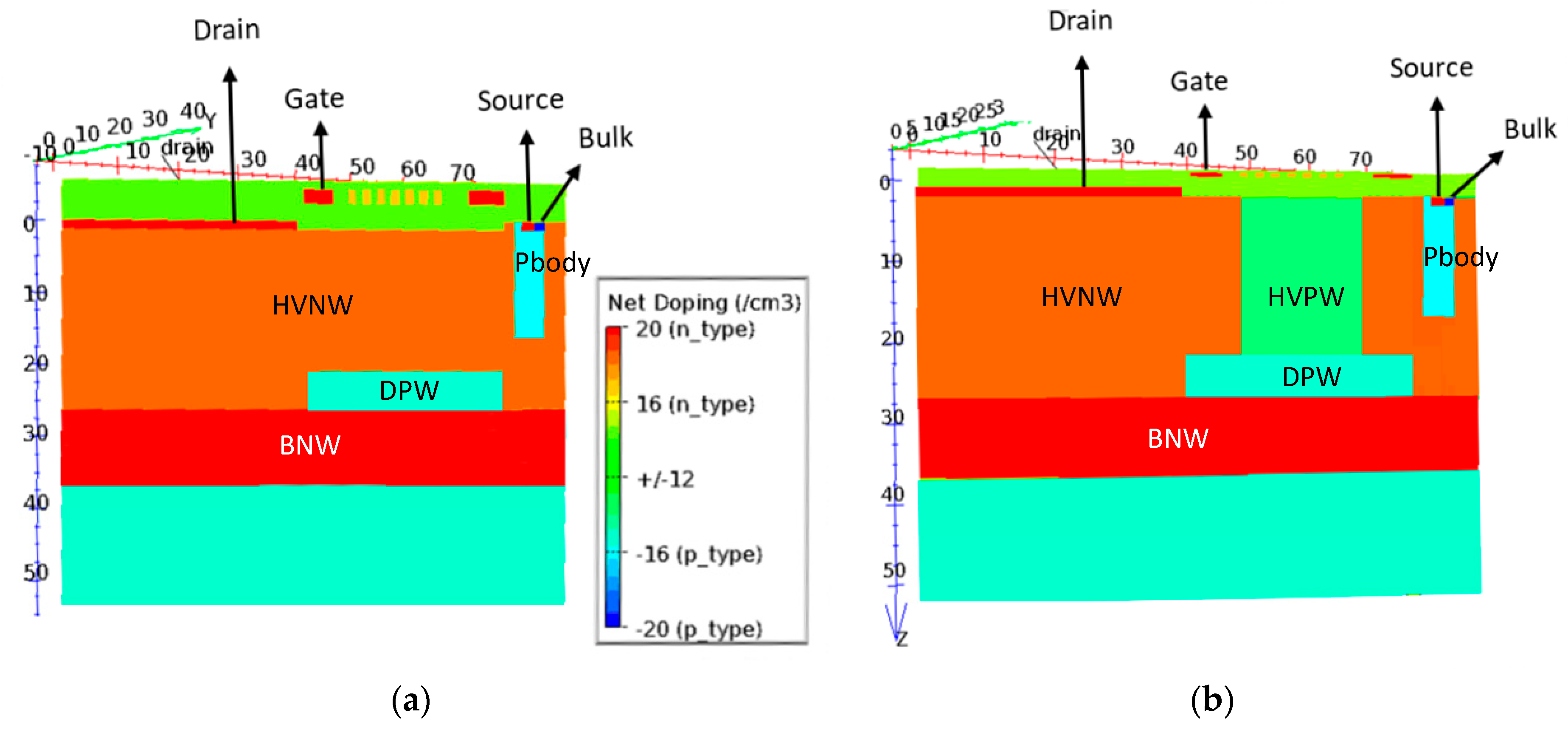
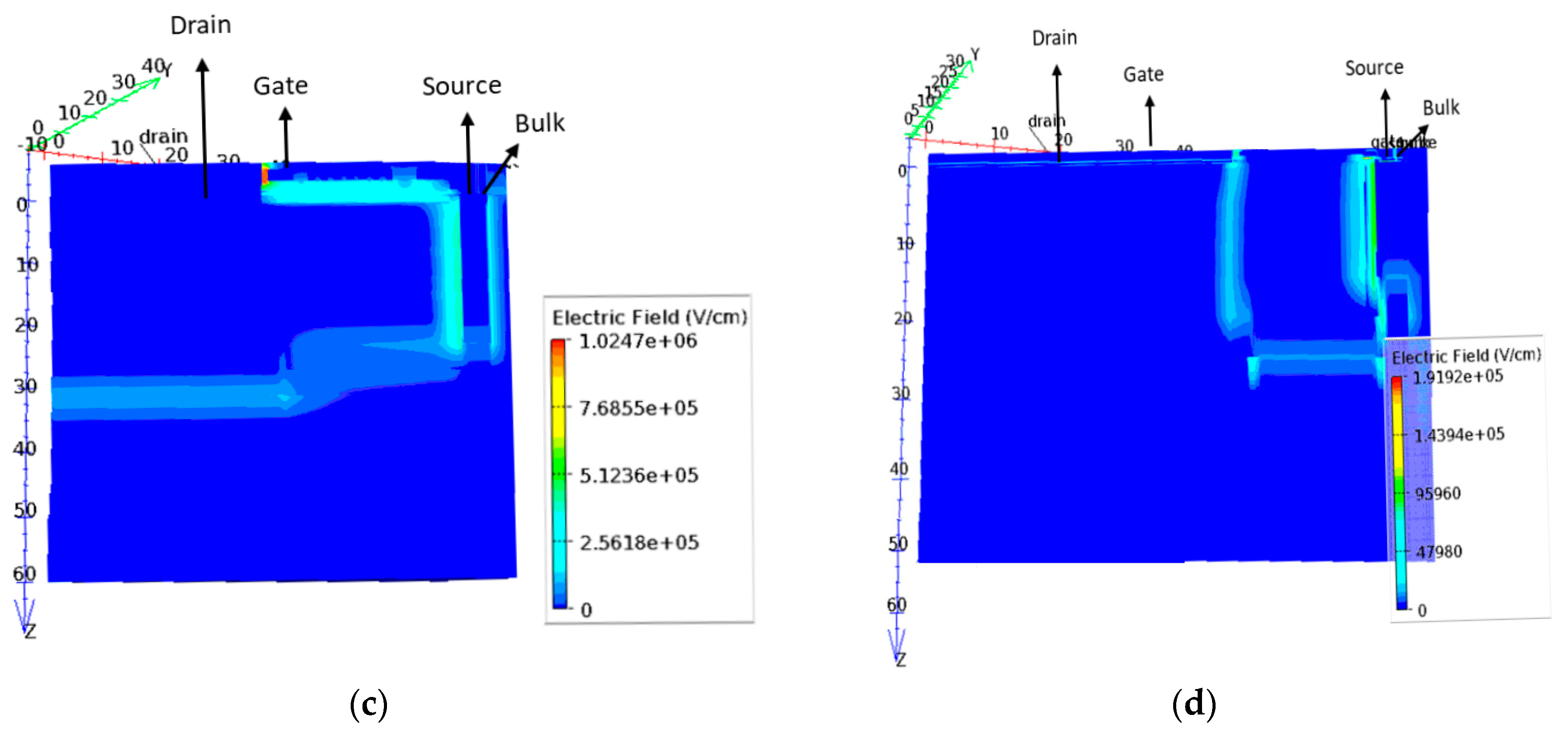
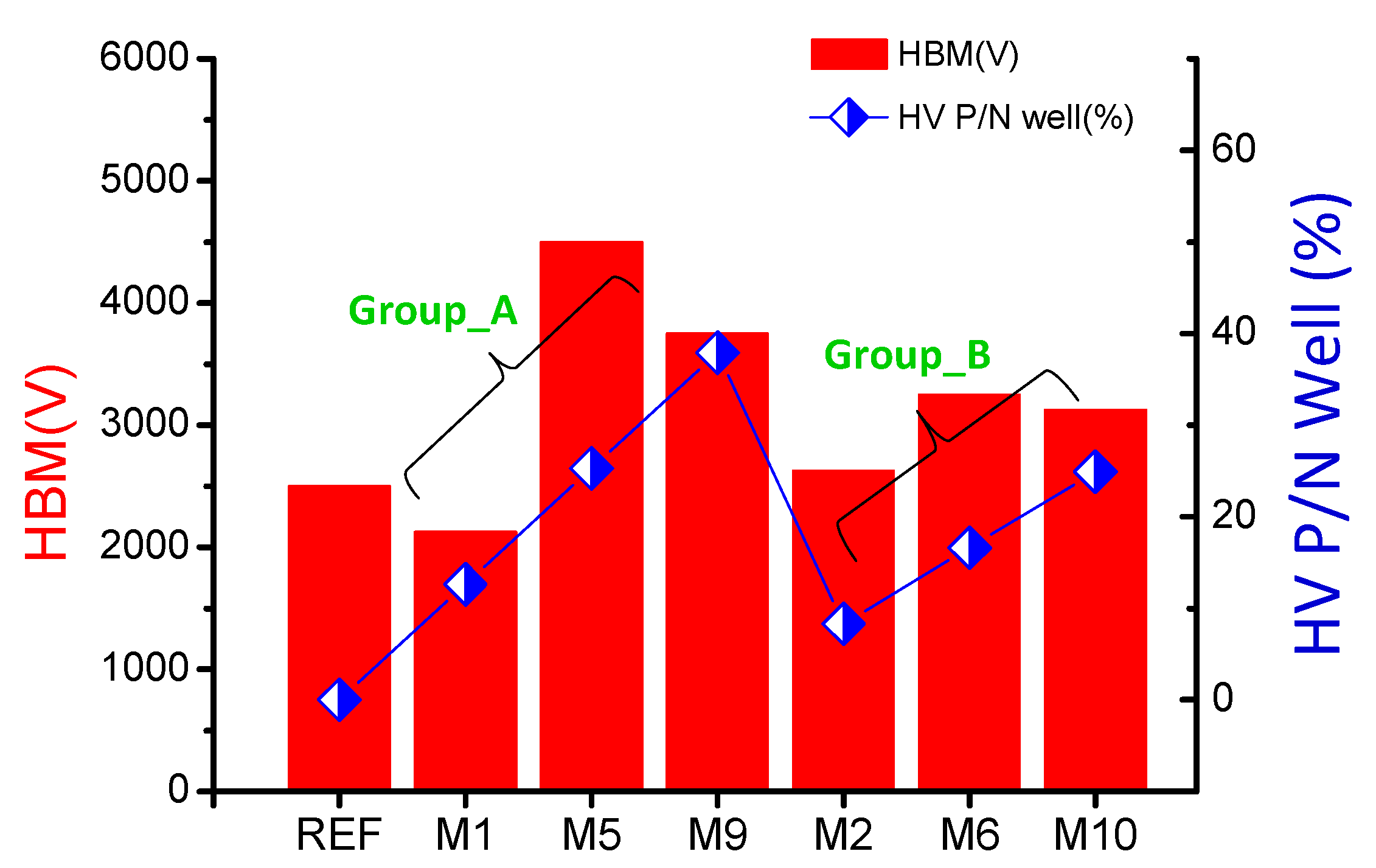
© 2020 by the authors. Licensee MDPI, Basel, Switzerland. This article is an open access article distributed under the terms and conditions of the Creative Commons Attribution (CC BY) license (http://creativecommons.org/licenses/by/4.0/).
Share and Cite
Chen, S.-L.; Wu, P.-L.; Chen, Y.-J. Robust ESD-Reliability Design of 300-V Power N-Channel LDMOSs with the Elliptical Cylinder Super-Junctions in the Drain Side. Electronics 2020, 9, 730. https://doi.org/10.3390/electronics9050730
Chen S-L, Wu P-L, Chen Y-J. Robust ESD-Reliability Design of 300-V Power N-Channel LDMOSs with the Elliptical Cylinder Super-Junctions in the Drain Side. Electronics. 2020; 9(5):730. https://doi.org/10.3390/electronics9050730
Chicago/Turabian StyleChen, Shen-Li, Pei-Lin Wu, and Yu-Jen Chen. 2020. "Robust ESD-Reliability Design of 300-V Power N-Channel LDMOSs with the Elliptical Cylinder Super-Junctions in the Drain Side" Electronics 9, no. 5: 730. https://doi.org/10.3390/electronics9050730
APA StyleChen, S.-L., Wu, P.-L., & Chen, Y.-J. (2020). Robust ESD-Reliability Design of 300-V Power N-Channel LDMOSs with the Elliptical Cylinder Super-Junctions in the Drain Side. Electronics, 9(5), 730. https://doi.org/10.3390/electronics9050730




